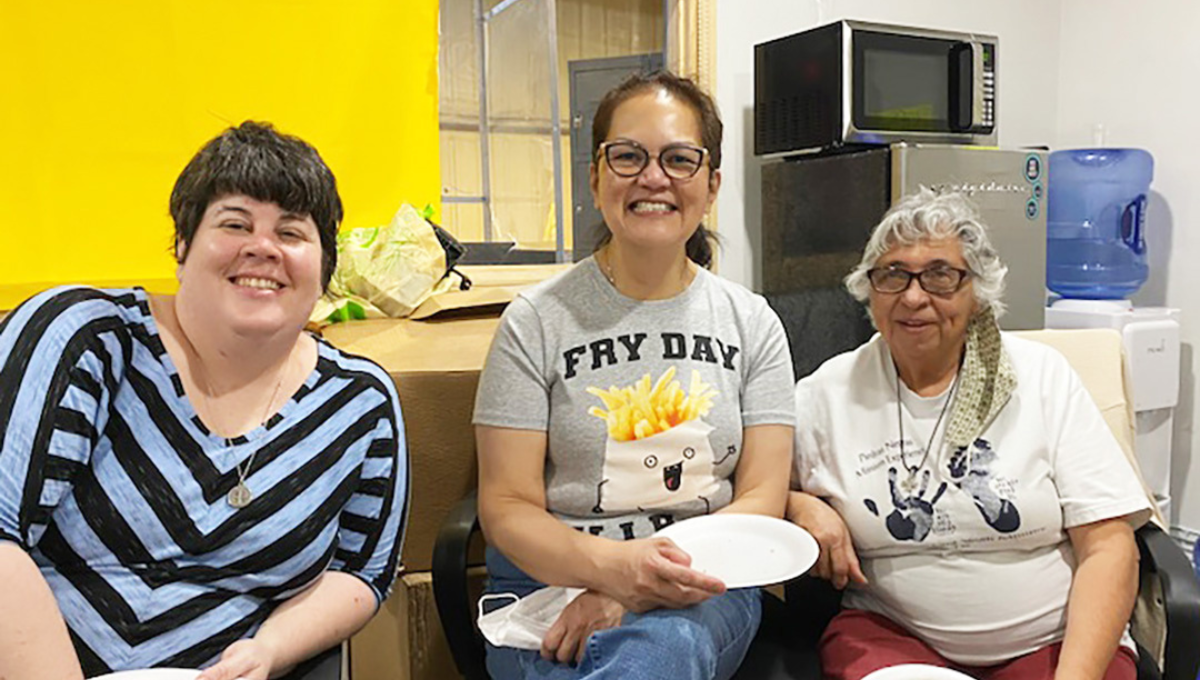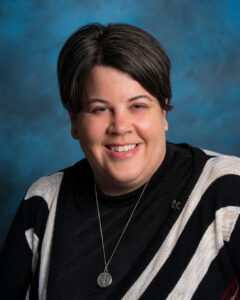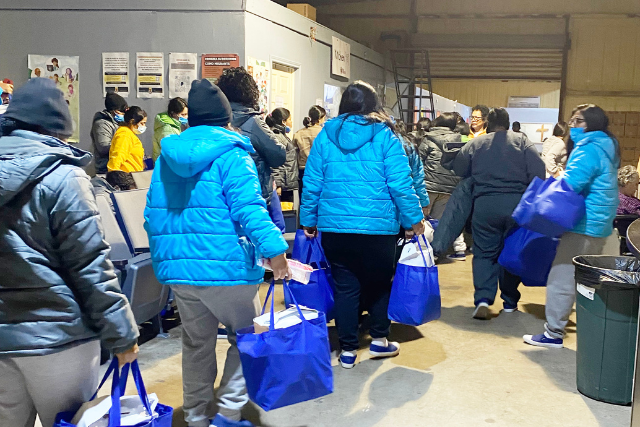
A Vocation Story by Dorothy Herring
Benedictine Sisters of Mount St. Scholastica
Volunteering on the Border
With support from our prioress Sr. Esther Fangman and the community of Mount St. Scholastica, I was blessed with the opportunity to volunteer in Eagle Pass, Texas, from January 9-19, 2023. I traveled with Sr. Siena Fisk, OSB, from St. Scholastica Monastery in Fort Smith, Arkansas, meeting up with Sr. Ursula Herrera, OSB, from Boerne, Texas, who runs the Caridad de Corazon - Charity of the Heart mission - in Eagle Pass, and in Piedras Negras on the Mexican side of the border.
The experience of seeing the process that immigrants and refugees go through in person at the border really opened my eyes to the social justice work that is being done. I also saw work that still needs to be addressed in treating all who seek refuge as children of Christ and with the dignity they all deserve. It moved me to see the teaching of Jesus - “Whatever you did for one of the least of these brothers and sisters of mine, you did for me” (Mt 25:35-36,40) - lived out in person.
Caridad de Corazon also includes a mission house where missionaries and volunteers stay. While we were in Eagle Pass, four other individuals or groups were also there. We were able to learn about other ongoing missions on both sides of the border. As most of the groups were regular visitors, it was wonderful to see the comforts of home that Sister Ursula provided for them at the mission house. A few of them brought meals to share and would make breakfast for us in the mornings, then gather together in the evenings for supper. Sisters Ursula, Siena and I also had a space in the living room to gather for morning and evening prayers.
 “I was a stranger and you welcomed me,” (Mt 25:35) is carried out daily at Mission Border Hope, a shelter in Seco Mines on the outskirts of Eagle Pass. Sister Ursula works with this non-profit organization, which was started by a Methodist minister, but became an ecumenical movement and is sponsored by many churches. At the shelter, volunteers and employees welcome individuals and families who have been processed by U.S. Customs and Border Protection (CBP). The shelter provides an orientation for the new arrivals, so they know where they are, and what they need to do so that they can continue on with their journey. Showers and toilets are available, as well as donated clothes, shoes, and personal toiletries if needed. Three meals a day are provided and there is a first-aid station. Prior to our arrival, the shelter was processing up to 1,000 refugees/asylum seekers a day, but that number decreased to about 100-150/day.
“I was a stranger and you welcomed me,” (Mt 25:35) is carried out daily at Mission Border Hope, a shelter in Seco Mines on the outskirts of Eagle Pass. Sister Ursula works with this non-profit organization, which was started by a Methodist minister, but became an ecumenical movement and is sponsored by many churches. At the shelter, volunteers and employees welcome individuals and families who have been processed by U.S. Customs and Border Protection (CBP). The shelter provides an orientation for the new arrivals, so they know where they are, and what they need to do so that they can continue on with their journey. Showers and toilets are available, as well as donated clothes, shoes, and personal toiletries if needed. Three meals a day are provided and there is a first-aid station. Prior to our arrival, the shelter was processing up to 1,000 refugees/asylum seekers a day, but that number decreased to about 100-150/day.
While we were at the shelter, we helped in the kitchen and the warehouse, where donated clothes and extra food supplies are stored. Sister Siena and I helped sort the clothes and assisted the immigrants trying to get new clothes. Some of the people who were there had their shoelaces confiscated at the Border Patrol detention centers, because they are considered a safety hazard, and were wearing just the shoes. Others had been wearing the same clothes for days or months without being able to wash them. Some of the immigrants just had on a t-shirt, sweatpants, thick socks and flip-flops.
Both Sister Siena and I brought donated shoelaces, socks, clothes, and shoes that had been collected. The Benedictine Sisters at Mount St. Scholastica had also ordered supplies that were shipped to Eagle Pass ahead of our trip. We were able to hand these out while we were there, but had to say no to some requests. We also put bags together by size for children that included a full outfit and extra underwear and socks.
The last full day that we were at Eagle Pass, we went across the border to Piedras Negras. We were accompanied by a couple who have volunteered along the border for over 30 years, and a Mexican minister who was also our interpreter. They are members of an organization called Operation Christian Love that provides support to people on both sides of the border. Our main goal was to take children and adults from Casa Bethesda, a home for special needs children, to lunch as a Christmas present. We also stopped at three homes that morning after crossing the border to drop off food and gifts for the children. As a nurse, when we visited two homes where family members were taking care of their adult loved ones who had severe medical needs, it was hard for me to see the conditions, knowing that if they had been in the U.S., families could have healthcare provided for their loved ones.
 Having lunch with the “children” of Casa Bethseda was a joy. Casa Bethseda was started to care for children who had been abandoned in the streets by their families because of their disabilities. We were told that the children would be waiting for us when we arrived. They were looking out of the gate and were so excited when we arrived. The children also look out for each other. One of the older boys would help one of the girls who is wheelchair-bound in and out of the vehicle. At the restaurant, they helped each other as needed in serving the food, or encouraging each other to try something, like the guacamole when one didn’t recognize what it was. They also enjoyed teasing each other, and us, on the rides to and from the restaurant. The children also have jobs at their home and, when we returned, some of them attended to their jobs right away, like taking in the trash bins. On the way back to Eagle Pass, we also visited Casa de Nazareth, an orphanage for babies and young children.
Having lunch with the “children” of Casa Bethseda was a joy. Casa Bethseda was started to care for children who had been abandoned in the streets by their families because of their disabilities. We were told that the children would be waiting for us when we arrived. They were looking out of the gate and were so excited when we arrived. The children also look out for each other. One of the older boys would help one of the girls who is wheelchair-bound in and out of the vehicle. At the restaurant, they helped each other as needed in serving the food, or encouraging each other to try something, like the guacamole when one didn’t recognize what it was. They also enjoyed teasing each other, and us, on the rides to and from the restaurant. The children also have jobs at their home and, when we returned, some of them attended to their jobs right away, like taking in the trash bins. On the way back to Eagle Pass, we also visited Casa de Nazareth, an orphanage for babies and young children.
For me, being able to build relationships with other men and women religious outside of my community encourages me with my continuing discernment and formation, as well as having friends who understand what I am going through. The advice and encouragement I received from those I met and visited on this trip was inspiring.
It was a learning experience to see all the legal processes involved for immigrants, refugees and asylum seekers to stay legally in the U.S, and also to see all the work that was being done to help them. Prior to this experience, my personal interaction with people seeking new lives in the U.S. was through serving on medical missions in Mexico and Colombia, and interactions with people in Kansas. In some ways, I saw the beginning and the end, but not the middle part of immigration.
Being a member of the Benedictine Sisters of Mount St. Scholastica encourages me to continue to seek ways that I may help others. The social justice issues, including immigration, that the sisters work to try and improve was the second most important aspect that drew me to the community; the first being the prayer life. Even though I will soon be entering into my canonical year of the novitiate and will not be able to leave the monastery to physically volunteer, I know there will be other ways that my experiences will be put to use, and the sisters will continue to encourage me to grow. Without community, I would not have had this experience. Community made this experience happen and I am most grateful.